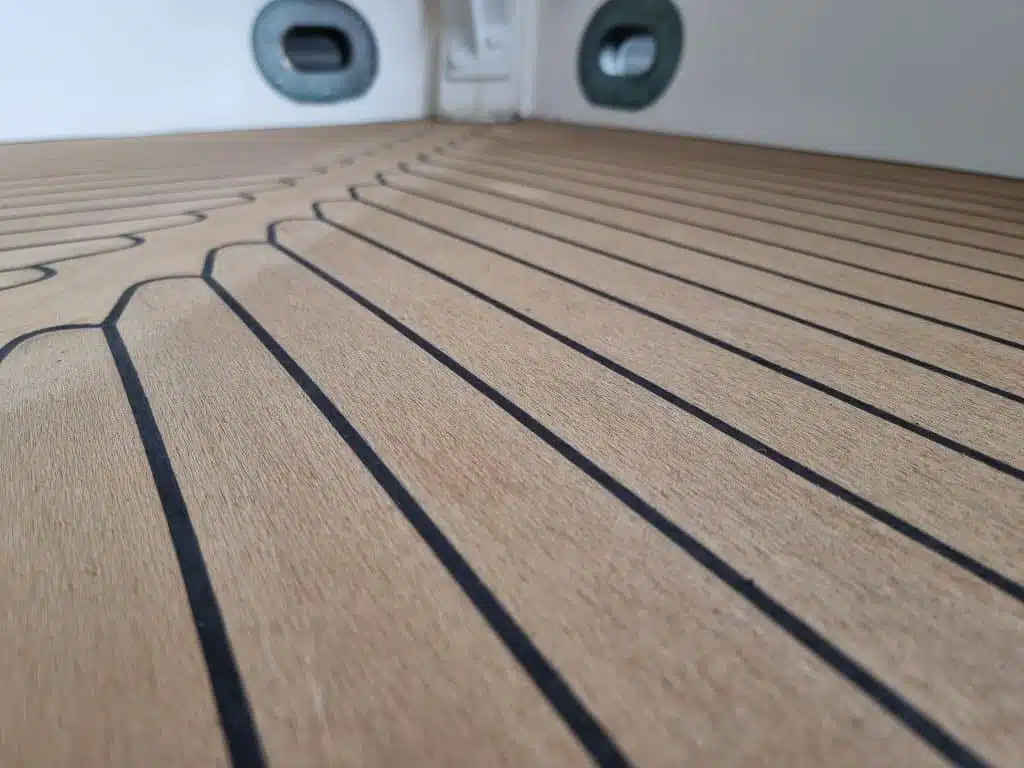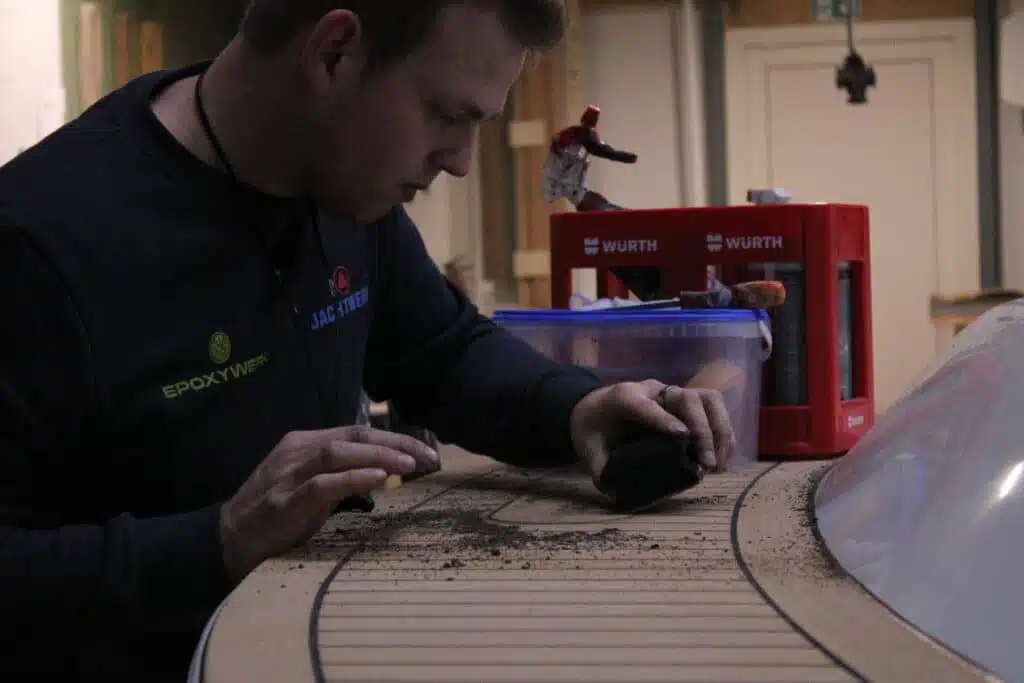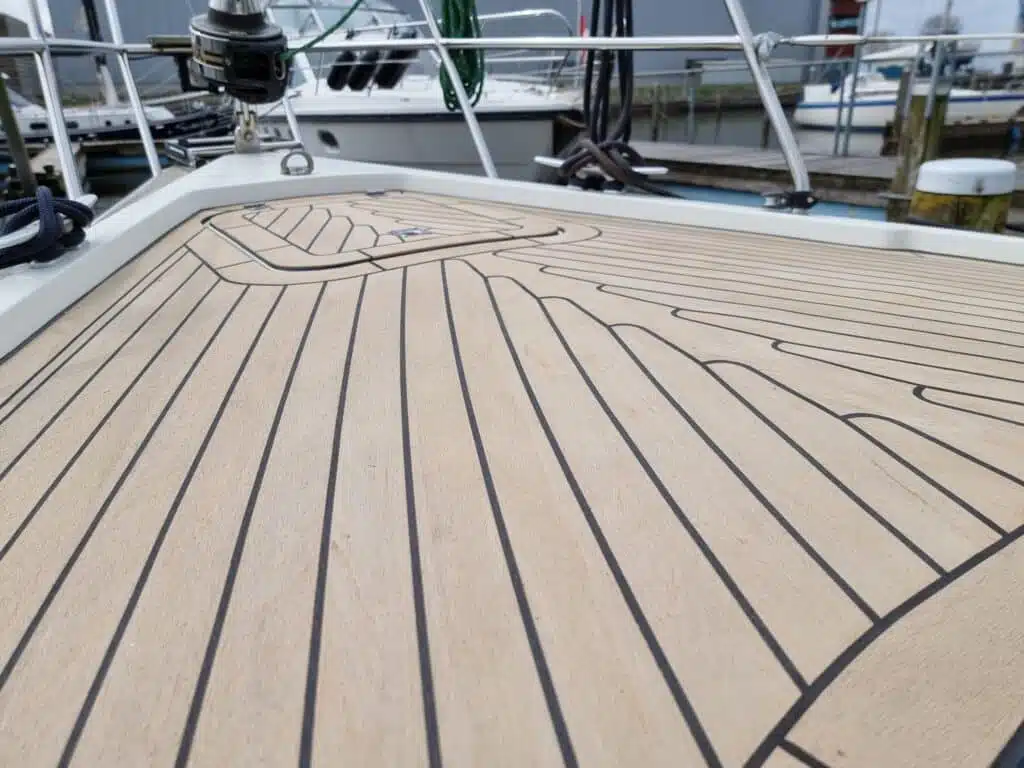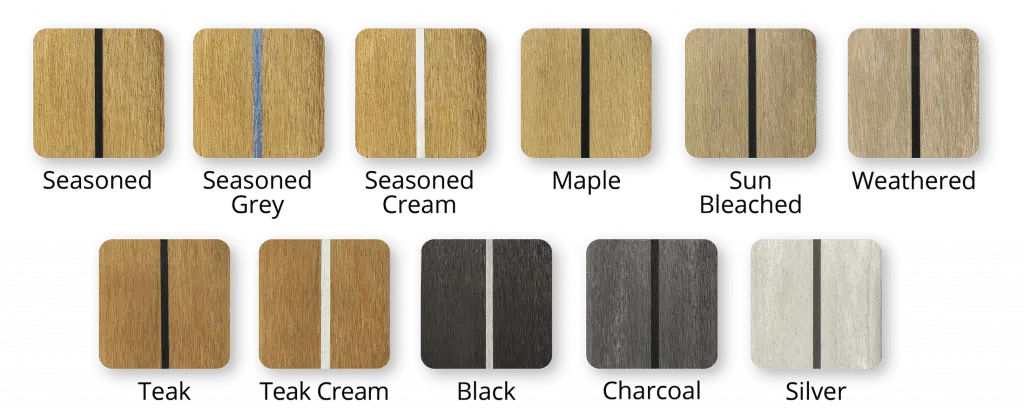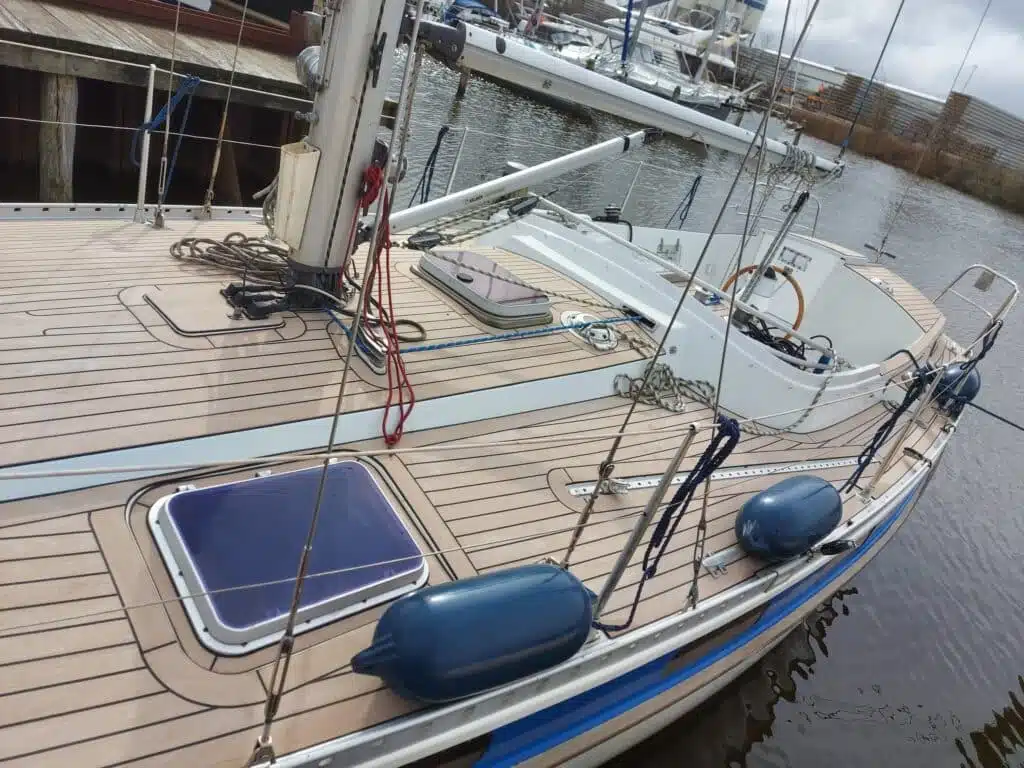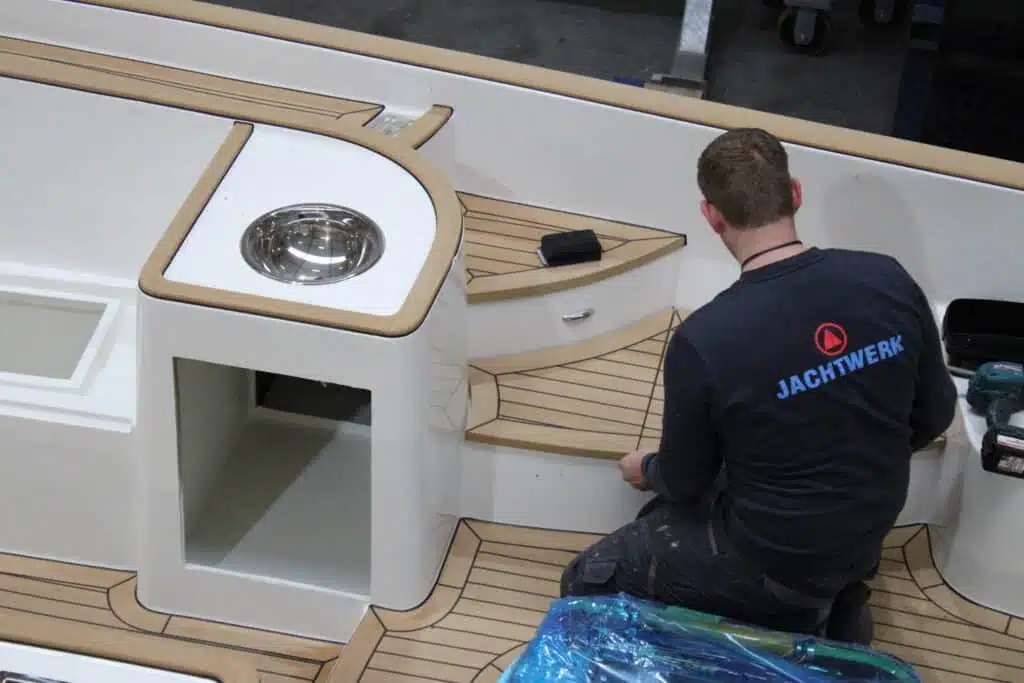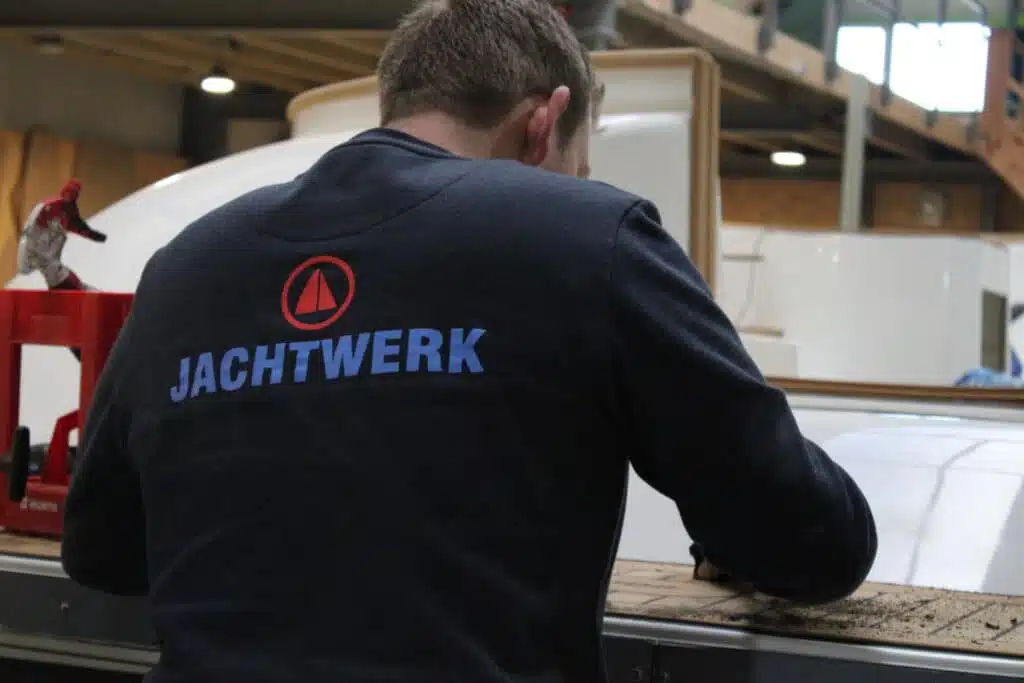Most frequently asked questions about synthetic teak decks + detailed explanation!
Thinking about giving your yacht a fresh look with a synthetic teak deck? Such a decision often involves many questions. You are certainly not alone in this contemplation. A boat is a personal place and every detail counts in your experience on the water.
At Jachtwerk, we find that many customers have the same questions when it comes to plastic teak decks. That's why we decided to create a handy overview for you. Whether you want to know about durability, the installation process, or maintenance, after reading this blog you will be completely up to date. That way, you'll make a confident choice for your boat.

Question 1: what is a synthetic teak deck?
A synthetic teak deck is an alternative to traditional teak decks on boats and ships.This deck is made of synthetic materials designed to imitate the look and texture of natural teak.Due to its special composition, the material is resistant to salt water, UV light and other weather conditions. Compared to traditional teak decks, a plastic teak deck is lighter in weight.Moreover, it can be applied to various substrates such as steel, wood and polyester and is suitable for both external and internal areas on a boat or ship.
Question 2: What are the benefits of synthetic teak decking?
If you are considering a synthetic teak deck, there are several benefits to consider.
Durability
Plastic teak decks are designed with longevity in mind. They withstand the daily wear and tear that could damage a traditional wooden deck, making them a long-term investment.
Mold-resistant
In humid climates, mold can be a problem on wooden decks. But synthetic teak decks offer a solution; they are resistant to mold, keeping the deck looking great longer.
Consistent color retention
While some materials can lose their color over time, synthetic teak decks retain their authentic look. This ensures that your boat will always look its best.
Anti-skid performance
Safety on board is crucial, and with the anti-slip properties of synthetic teak decks, you can be confident that the deck will remain safely passable even in wet weather.
Question 3: Can you install a synthetic teak deck yourself?
Yes, it is certainly possible to install a synthetic teak deck yourself.
Companies like Jachtwerk make it easier for do-it-yourselfers by offering a panel service. With this service, the product is delivered to size, along with the necessary glue and other supplies to complete the project.While installation can generally be simple, it is a job that requires precision. Mistakes during installation are easily made, especially since it is such a precise job. Therefore, although self-installation is an option for the handy boat owner, it is often recommended to hire a professional. A professional installation not only ensures flawless installation, but also guarantees the best results and long life of the deck.
Question 4: How long does a synthetic teak deck last?
A synthetic teak deck is known for its durability and longevity.
Most synthetic teak decks, when properly maintained, have an expected lifespan of 20 years or even longer. Of course, how the deck is used and how it is maintained plays a significant role in how long it actually lasts. It is also worth noting that, unlike some traditional materials, synthetic teak is less susceptible to external factors such as UV rays, salt water and mold. This resistance to the elements contributes to the extended life of the deck.In addition, if properly cared for and cleaned regularly, the deck can retain its original appearance, keeping your boat looking fresh and well maintained for years to come.
Question 5: How do you maintain a synthetic teak deck?
Maintaining a synthetic teak deck is relatively easy, which contributes to its popularity among boat owners.
For daily maintenance and light soiling, regular cleaning of the deck with water and a mild soap is sufficient. This simple operation helps keep the deck fresh and prevents accumulation of dirt. In cases of more serious soiling, such as stubborn stains or caked-on dirt, using a high-pressure cleaner can be an effective solution. However, it is advisable to be careful with the pressure settings to avoid damaging the surface.
It is also a good idea to regularly inspect the deck for any damage or signs of wear. Although synthetic teak decks are durable, timely detection of minor problems can help prevent larger repairs in the future. Overall, with proper care and attention, a synthetic teak deck will last for years and continue to look great.
Question 6: Should you oil or varnish your synthetic teak deck?
One of the advantages of a synthetic teak deck is the minimal maintenance it requires, and this includes finishing the surface.
Unlike natural teak, there is no need to oil or varnish a synthetic teak deck. Natural teak requires regular treatments to maintain its color and integrity, but this is not the case with synthetic teak. The synthetic material retains its color and texture without the need for additional finishes. This not only saves time and effort in terms of maintenance, but it also means that there are no additional costs for oils or varnishes over the life of the deck.
Question 7: Are all synthetic teak decks the same quality?
As with many other products, the quality of synthetic teak decks varies depending on several factors.
It is a misconception to think that all synthetic teak decks are equal in quality and durability. The quality of a synthetic teak deck can vary greatly depending on the manufacturer and the materials used. Some manufacturers may choose cheaper materials or manufacturing processes that can affect the life and appearance of the deck. In contrast, there are brands such as Top Deck that are committed to using only the highest quality components. This makes for a deck that not only has beautiful appearance, but also performs for a long time under various conditions.
When considering an investment in a synthetic teak deck, it is essential to research the manufacturer and understand what materials and methods they use. A high-quality deck not only offers a better look but can also save costs in the long run through longer life and less maintenance.
Question 8: What does a synthetic teak deck cost?
The cost of a synthetic teak deck can vary based on several factors, including the size of the deck, the design and the specific manufacturer.
In general, synthetic teak decks are more financially attractive and less expensive than natural teak, making it an attractive option for many boat owners.
It is also important to remember that while the initial investment for a synthetic teak deck may be lower, the long-term benefits, such as reduced maintenance and durability, can provide further cost savings.
For those interested in a specific quote, we offer a handy deck designer. This allows you to enter your desired design and specifications to see a sample of the final result. In addition, you can request an instant price, giving you a clear idea of the expected cost for your boat.
Question 9: Are synthetic teak decks a good investment?
Synthetic teak decks are considered by many to be a wise investment for boat and ship owners.
There are several reasons why they are a preferred choice for many. First, they offer significant durability. Unlike natural wood, which can be susceptible to wear and tear from weather and constant exposure to water, synthetic teak decks are designed to withstand these elements.
In addition, maintenance of synthetic teak decks is relatively simple and easy. This means owners need to spend less time and money on routine care and repairs. Over the life of the deck, these savings in maintenance costs can add up significantly.
Therefore, when you combine the benefits of durability and easy maintenance, synthetic teak decks often prove to be a cost-effective and valuable long-term investment for boat owners.
Question 10: Are there different color options?
Yes, there are different color options available for synthetic teak decks. This gives boat and ship owners the flexibility to choose a color that perfectly suits the boat and personal preference. At Jachtwerk, we have expanded the range to meet a variety of needs and offer 12 color options.
Some of our popular colors include black, silver, weathered, teak, seasoned gray, charcoal and seasoned cream. This variety allows customers to add a unique and personalized touch to their boats or vessels.
Question 11: Can I make a custom design for my synthetic teak deck?
Absolutely! When choosing a teak deck, it is important that it matches the style and character of your boat or vessel. That's why providers like Jachtwerk offer the ability to elaborate on any design or idea you have in mind. Are you going for a specific pattern? A unique color combination or other creative input? This is possible with synthetic teak decks.
And for those who want to give their boat or vessel an even more personal touch, it is even possible to incorporate logos into the deck. This can be a wonderful way to distinguish your vessel and make a statement.
Question 12: Can synthetic teak decks discolor?
Yes, it is possible that some synthetic teak decks can discolor over time, especially when continuously exposed to direct sunlight and other external factors. This discoloration problem is often related to the quality of the materials used and may be more common with cheaper options.
It is important to inquire about the quality and resistance to discoloration when purchasing a synthetic teak deck. There are materials available that are specifically designed to retain their color even after years of exposure to the elements. Thus, choosing a high-quality material can help ensure that the deck continues to look great without worrying about possible discoloration.
Question 13: Are synthetic teak decks slippery when wet?
A common concern when choosing decking is safety, especially when the deck gets wet. Fortunately, synthetic teak decks have a non-slip surface. This means that even when the deck is wet from rain, waves or other conditions, the risk of slipping is significantly reduced.
Question 14: Are synthetic teak decks suitable for saltwater environments?
Synthetic teak decks are specifically designed to perform well in a variety of environments, including saltwater locations. They are highly resistant to the corrosive effects of saltwater. This makes them particularly suitable for ships and boats that frequently operate in sea or ocean waters.
Question 15: Can I have my existing deck replaced with synthetic teak deck?
Certainly, replacing an existing deck with a synthetic teak deck is a viable option. Removal or demolition of the old deck can be done by specialized teams on an hourly basis. If you are considering some cost savings, you can also choose to do it yourself. Once the old deck is removed, the new synthetic teak deck can be installed as required. However, it is always advisable to seek professional advice on the best process for your particular situation.
Question 16: Are synthetic teak decks scratch resistant?
Synthetic teak decks are designed with durability in mind and are reasonably scratch-resistant. However, they are softer than traditional wood, which means they can be a bit more susceptible to damage under certain circumstances. That said, if deep scratches do occur unexpectedly, it is reassuring to know that repair is possible. This allows you to maintain the appearance and functionality of the deck even after an unfortunate damage. It is always a good idea to use caution and handle heavy or sharp objects carefully on the deck.
Question 17: Is it possible to replace only part of my deck with synthetic teak?
It is indeed possible to replace only part of your deck with synthetic teak. However, one challenge you may run into is finding a perfect color match to the original deck. This is because the color and wear and tear of existing parts can vary over the years. A complete replacement then offers the assurance of uniformity and appearance, often producing a more beautiful and cohesive result.
Question 18: How heavy are synthetic teak decks?
Synthetic teak decks are generally lighter than their natural teak counterparts. This weight advantage can contribute to vessel stability, as a lighter deck can positively affect the overall balance and weight distribution of the vessel. To illustrate, the second generation of synthetic teak currently available is already 2 kilograms lighter per square meter compared to the first generation. This shows that there are continuous developments in optimizing the quality and weight of synthetic teak decks.
Question 19: Is it possible to make repairs to a damaged synthetic teak deck?
Certainly, repairs to a synthetic teak deck are feasible. However, depending on the nature and extent of the damage, a subtle difference in appearance may be visible after the repair. This difference may have to do with things like color, texture or the seam between the original and repaired part. Although the result is often close to the original, it is good to realize that seamless integration can sometimes be challenging. It is therefore advisable to seek professional advice on the best approach and expected outcome of a repair when damage occurs.
Question 20: Is there a difference in walking comfort between natural teak and synthetic teak?
In general, most people experience the walking comfort of both natural teak and synthetic teak as similar. Both materials offer a firm grip and feel comfortable underfoot. Although the texture may differ slightly between the two, the differences are often minimal in terms of comfort while walking or standing. However, the temperature of the material can vary under direct sunlight, which can affect the feel. So it is always a good idea to consider the specific properties of the chosen material, but in general terms, you can be confident that both options are comfortable for everyday use.
Question 21: How are synthetic teak decks attached?
Synthetic teak decks are fastened with a specific 2-component adhesive specifically designed to provide a durable and waterproof joint. This adhesive ensures that the deck adheres well to the substrate, making it resistant to daily loads and the elements. After bonding, the edges and seams of the deck are carefully sealed. This sealing with sealant prevents water from getting under the deck and also provides a sleek finish. The entire process of gluing and sealing ensures that the deck is not only securely attached, but also protected from moisture and weather for a long time.
Question 22: Are there synthetic teak decks for indoor use?
Certainly. Synthetic teak decks are excellent for indoor use. Although these decks are often associated with outdoor areas of ships and boats, their properties and finish make them equally suitable for interiors. For indoor use, plastic decks are usually sanded finer, resulting in a smoother texture. This gives a more refined look and makes the material feel more comfortable underfoot.
Question 23: Are special cleaning products needed for synthetic teak?
For optimal cleaning and preservation of the quality of synthetic teak, it is advisable to use specific cleaning products designed specifically for this material. Indeed, there are special cleaning products available for synthetic teak decks. For example, some suppliers, such as Top Deck, offer their own cleaning product formulated to preserve the appearance of synthetic teak while thoroughly cleaning it. This product can be purchased for about 20 euros.
Question 24: Are synthetic teak decks susceptible to algae growth?
In general, synthetic teak decks are designed to resist common problems such as algae and fungus growth. Thanks to special treatments and the inherent properties of the materials used, many synthetic teak decks, such as those made by some brands, are resistant to algae and mold. This means that they require less maintenance in environments where algae can often be a problem, and ensures that the deck stays beautiful longer. However, it is still advisable to clean the deck regularly to prevent accumulation of dirt and possibly breeding grounds for algae.
Question 25: How long does it take to install a synthetic teak deck?
The time it takes to install a synthetic teak deck can vary depending on several factors. First, the size of the deck plays a significant role: larger decks logically require more time. In addition, the complexity of the chosen design can affect installation time. Complicated patterns or specific modifications can increase installation time. However, compared to natural teak, synthetic teak decks generally offer faster and more efficient installation. This is because they are manufactured to be consistent in size and shape, which simplifies the installation process.
Question 26: Are synthetic teak decks suitable for all boats?
Synthetic teak decks are versatile in their applications and can be installed on a wide range of boats. Whether it is sailing boats, where the deck is often exposed to the elements and frequent foot traffic, or luxury motor yachts where aesthetics and comfort are crucial, synthetic teak meets the requirements. The material's flexibility and durability allow it to adapt to the contours and needs of various vessel types.
My question is not in this list....
After reading this list, do you still have questions about synthetic teak decks? Are you unsure which synthetic teak deck will best fit your boat or yacht and your specific needs? No worries! The professionals at Jachtwerk are ready to answer all your questions about synthetic teak decks.
Jachtwerk has years of experience in the marine industry and specializes in synthetic teak decks. We are happy to provide you with expert advice. Feel free to contact us or visit our office, we look forward to seeing you!
